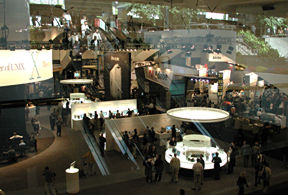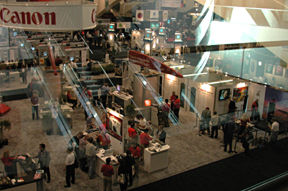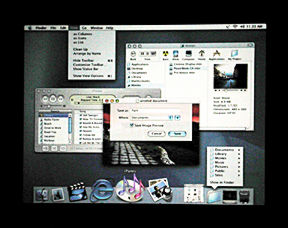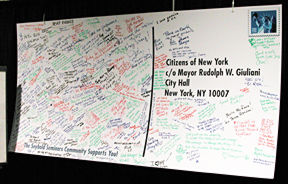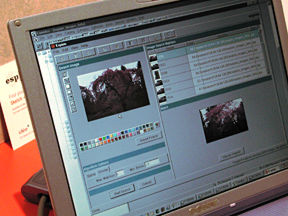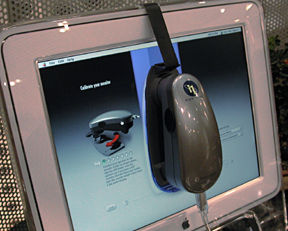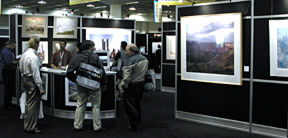| The Seybold SF 2001 report | |
SEYBOLD SAN FRANCISCO
Seybold (Re)invents Electricity
By MIKE PASINI
Editor
Imaging Resource Digital Photography NewsletterSAN FRANCISCO -- Like the electrical storm that blew through the Bay area Monday, Seybold San Francisco 2001 today sent bolts of excitement through the darkness that has masked our skyline. Publishers big and small stood on the floor, their kites waving and keys sparkling like the descendants of Ben Franklin they really are, hoping to catch some of that excitement and bottle it.
Overview of the Show Floor
Both North and South Halls were openIncreased security handled a somewhat smaller than usual crowd (no one could say whether that had more to do with terrorists or venture capitalists). Some 22 companies -- among them Kodak and Nikon -- of approximately 300 cancelled in the last two weeks.
The Canon Booth
Digicams lower centerAn initial ban on photographs from the show floor was lifted Tuesday after security measures for photographers were implemented. Some exhibitors, nevertheless, asked us not to shoot.
MAC OS X UPDATE
The first lightning bolt of the show was the release of Mac OS X version 10.1 at the special keynote speech by Steve Jobs in which he touted Microsoft Office v.X as "the poster child" of OS X. Judge for yourself with the free download of the beta version of Word.
Mac OS X version 10.1
From the cheap seatsJobs quickly left the floor to Phil Schiller, vice president of worldwide product marketing, who got down to business. He assured the crowd that the new OS X was much faster than its predecessor, launching applications two to three times faster and resizing windows five to ten times faster.
Release 10.1 adds support for burning DVD-Rs, includes a new DVD player and iDVD 2, improves network connectivity and enhances the user interface with options like a customized dock and a set of color-neutral desktop backgrounds.
But for imaging enthusiasts like us the big news was two-fold:
- ColorSync 4.0 -- now fully integrated into the operating system, capable of automatically calibrating your monitor and automatically applying ICC profiles.
- A built-in Image Capture application -- It recognizes devices like printers and digicams, embeds profiles automatically and enables color proofing on your monitor.
We took an extended look at both of these developments a little later on the show floor and report on them in depth below.
Apple continues to push DVDs for still imaging slide shows, much to our amazement (so what if you can play them on low-quality televisions?). The argument is that you can make a nicer presentation, using the remote control to navigate and easily adding music or any other QuickTime-compatible sound, even queuing the slide change intervals to the music. Blanks cost $10 each.
But the sound recordings saved with your JPEG images aren't understood by the iDVD 2 software. To actually use your own annotations, you'd have to export them and convert them to QuickTime.
But save yourself the trouble. Canto Cumulus can already build a QuickTime slide show from your JPEGs with your sound annotations. And you can write them to CD where you'll get a better show on your monitor.
APPLESCRIPT
Big news here, too, with the demo of AppleScript Studio, a professional development environment that brings Project Builder and Interface Builder from WebObjects to AppleScript.
This gives OS X not only automation but a tool to program automation that also makes it easy to put an attractive interface on any scripting project. AppleScript finally goes to the prom -- with a few bucks in its pocket.
With an image processing engine built into the OS, Sal Soghoian demonstrated how to pull images from the camera to the desktop, rotate them and even size them in a browser with no more magic than a script.
GETTING THE UPDATE
Apple is making it easy to get the update, going so far as to pass it out at the door to departing audience members. It's also available for the asking at the Apple Booth. And will be available at no charge as an update at your Apple dealer through Oct. 31. The full product retails for $129.
FLAGS FLYING
On the show floor, exhibitors and attendees expressed their patriotism in subtle ways.
One was by being there, of course. But Seybold also set up two large postcards to New York City Mayor Rudy Giuliani, inviting attendees to scribble their sympathies. And images of New York City were rolling off at least one large inkjet printer we saw.
Wish You Were Here
Click for an enlargementAnd among the more demonstrative was, we understand, Adobe's gift of GoLive! to the first 1,000 attendees.
RODS & CONES
We had the pleasure of attending a ColorSync presentation at Web 2001 just a few days ago given by Son Do, Rods & Cones president. His company customizes color management and workflow for graphics professionals. And while Rods & Cones will build ICC device profiles for customers for $100 each, they'll also edit them to suit (and over the phone, too).
But when we chatted with him at Seybold, we learned some interesting things about calibrating cameras and printers. He doesn't feel it's worthwhile to calibrate digicams, inkjet and dye sub printers. The output of the printers is too variable to nail down, he said. And the conditions in which you use a digicam make calibration useless. You simply have no control of the light.
He does calibrate high-end studio cameras where the lighting is completely controlled. And printers whose output can be reliably repeated can be reliably corrected, he pointed out.
When you're shooting with a digicam, he said, you're typically aiming for "believable color." But in the studio, you are trying to precisely match a color (perhaps of a particular product). And you can only do that if you control all the variables.
But don't tell that to the burgeoning calibration business!
COLORSYNC 4
We chatted with David Hayward, Apple software engineer, about ColorSync 4. It relies, he said, on USB protocols and sub-protocols to identify devices as you plug them in.
He had a Canon D30 that he plugged in and before our very eyes, OS X recognized it. Image Capture popped up and displayed thumbnails of all the images in the camera, let us rotate them and download them to the hard drive. The camera's preferences included which ICC profile to embed in its images and where to download its images.
Similarly printers identify themselves to OS X and their profiles are automatically engaged. You can still select different ones for different media in the Print dialog box. But you don't have to bother with the Chooser anymore. USB does all that for you.
And built into every Apple LCD display is rudimentary color data that permits OS X to build a profile for it. It's fixed data, so it doesn't account for life after the display leaves the factory floor, but it's a starting point for calibration.
IMAGE CAPTURE
Image Capture is actually an application included with OS X. It's a nice first step.
Among its preferences are options to set the camera time and date on connect. So when you plug the USB cable from your Mac to your digicam, it will synchronize your digicam's clock to the Mac.
It can also delete images on your digicam after they've been downloaded to the Mac. We always caution against this (let the digicam do it after you've backed up your images), and don't mind repeating ourselves it here. You can never be too careful.
Image Capture provides two views of your images: thumbnails and list view. In list view you can even see some Exif metadata like f stop, exposure and flash setting. You set which items to list in a Preference, but not all the metadata is available.
ESPION
We got our first look at Idee's Espion, which has been integrated into Canto Cumulus to retrieve images by, well, looking at them (rather than using keywords).
The Espion Interface
Reference image (l), results list (top right),
most likely (bottom right)Image searching software based on visual comparison has been a very tough nut to crack but the demo we got from Leila Boujnane, Idee chief executive officer, gave us more than hope.
Espion indexes images according to several criteria: shape, color, texture, foreground, background, composition, contrast and luminance among them. It actually scans the bitmap for each image to evaluate each criteria. One image requires between 0.5K to 1.0K for the index entry and Espion is smart enough to reindex any modified image on the fly.
We searched a database of 3,895 photographic images using several methods. None of the searches took more than a few seconds to list possible matches graded by percent. Some hits were in the 90s and credible matches existed down to about the 60s. Boujnane said the usefulness of the match drops off significantly around 30 percent.
The index criteria are evenly weighted at the moment, but will be selectable so users can weigh, say, shape over texture.
Meanwhile, Boujnane demonstrated a really slick "sketch" mode where the reference image used to key the search is, well, anything you sketch in the image window. Now you can actually retrieve an image that "looks like" some scrawl you can draw! Charades will never be the same.
LCD CALIBRATION
At the Apple booth we noticed they were using the new Eye-One spectrophotometer device from GretagMacbeth to calibrate their LCD displays. So we hustled over to the GretagMacbeth booth to chat with Patrick Endaya, director of sales, who gave us the complete demo.
The Eye-One Spectrophotometer
A weight behind the monitor keeps it against the screenUnlike color calibration devices for CRTs, the Eye-One has a soft rubber gasket where it touches the LCD screen and a strap with a rubber weight to keep it against the flexible display (rather than the suction cups used to attach devices to the hard glass of CRTs).
The GretagMacbeth solution isn't cheap at $3,000 (down from their professional version for $10,000), but it was easy to use and understand and can also profile printers and scanners.
In addition, Endaya told us GretagMacbeth has set up a Web site to help foster discussion of color calibration.
THE ULTIMATE UNERASE
Since digicams were invented, photographers of all stripes have wanted to know one thing: "How do I unerase my storage card?!" And we have dutifully enumerated every trick we've learned in our newsletter, explaining the physical and logical formats and the software options available.
But if all our advice fails you, DriveSavers won't. Even, we were assured, if you reformat your card. Yes, even then (because cameras only do a logical format).
For $140 they'll scrape everything off your CompactFlash, SmartMedia, Memory Stick or MMC and write it to a CD. And if they can't help, they won't charge you.
A TREAT
We couldn't miss one rather large booth in the North Hall -- not because of its size but because of the gorgeous images on its walls. In fact, it seemed to be something like a gallery.
Stephen Johnson Indeed it was. The work of Stephen Johnson, the large framed scenic prints were imaged with a Dicomed and Better Light 4x5 digital camera, transferred to a PowerBook and printed seamlessly on various papers. Each image is a 140-MB file. But Johnson also makes 370-degree panoramas of over 1-GB.
Gorgeous stuff.
MONSTERS
Leaving Moscone, we reviewed everything we'd seen and heard from the keynote to Johnson's beautiful prints. But we kept coming back to one moment during the keynote demo of iDVD 2. The quick and easy assembly of several QuickTime clips included -- surprise -- a Pixar trailer of Monsters, Inc., scheduled for release Nov. 2.
Monsters, the trailer tells us, have a secret. They are afraid of us -- and especially afraid of "human kids."
There aren't any kids at Seybold as a general rule (virtual kids, sure, but not real ones). And, while there may be monsters out there, there weren't any of them at Seybold either. Just a bunch of publishers picking up where that old patriot Ben Franklin left off.
And we plan to join them tomorrow to continue our coverage of Seybold San Franciso 2001.
